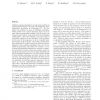Free Online Productivity Tools
i2Speak
i2Symbol
i2OCR
iTex2Img
iWeb2Print
iWeb2Shot
i2Type
iPdf2Split
iPdf2Merge
i2Bopomofo
i2Arabic
i2Style
i2Image
i2PDF
iLatex2Rtf
Sci2ools
97
Voted
RECOMB
1997
Springer
1997
Springer
A branch-and-cut algorithm for multiple sequence alignment
Multiple sequence alignment is an important problem in computational biology. We study the Maximum Trace formulation introduced by Kececioglu [?]. We first phrase the problem in terms of forbidden subgraphs, which enables us to express Maximum Trace as an integer linear-programming problem, and then solve the integer linear program using methods from polyhedral combinatorics. The trace polytope is the convex hull of all feasible solutions to the Maximum Trace problem; for the case of two sequences, we give a complete characterization of this polytope. This yields a polynomialtime algorithm for a general version of pairwise sequence alignment that, perhaps suprisingly, does not use dynamic programming; this yields, for instance, a nondynamic-programming algorithm for sequence comparison under the 0-1 metric, which gives another answer to a long-open question in the area of string algorithms [?]. For the multiple-sequence case, we derive several classes of facet-defining inequalities ...
Computational Biology | Maximum Trace | Maximum Trace Formulation | Multiple Sequence Alignment | RECOMB 1997 |
Related Content
| Added | 08 Aug 2010 |
| Updated | 08 Aug 2010 |
| Type | Conference |
| Year | 1997 |
| Where | RECOMB |
| Authors | Knut Reinert, Hans-Peter Lenhof, Petra Mutzel, Kurt Mehlhorn, John D. Kececioglu |
Comments (0)

